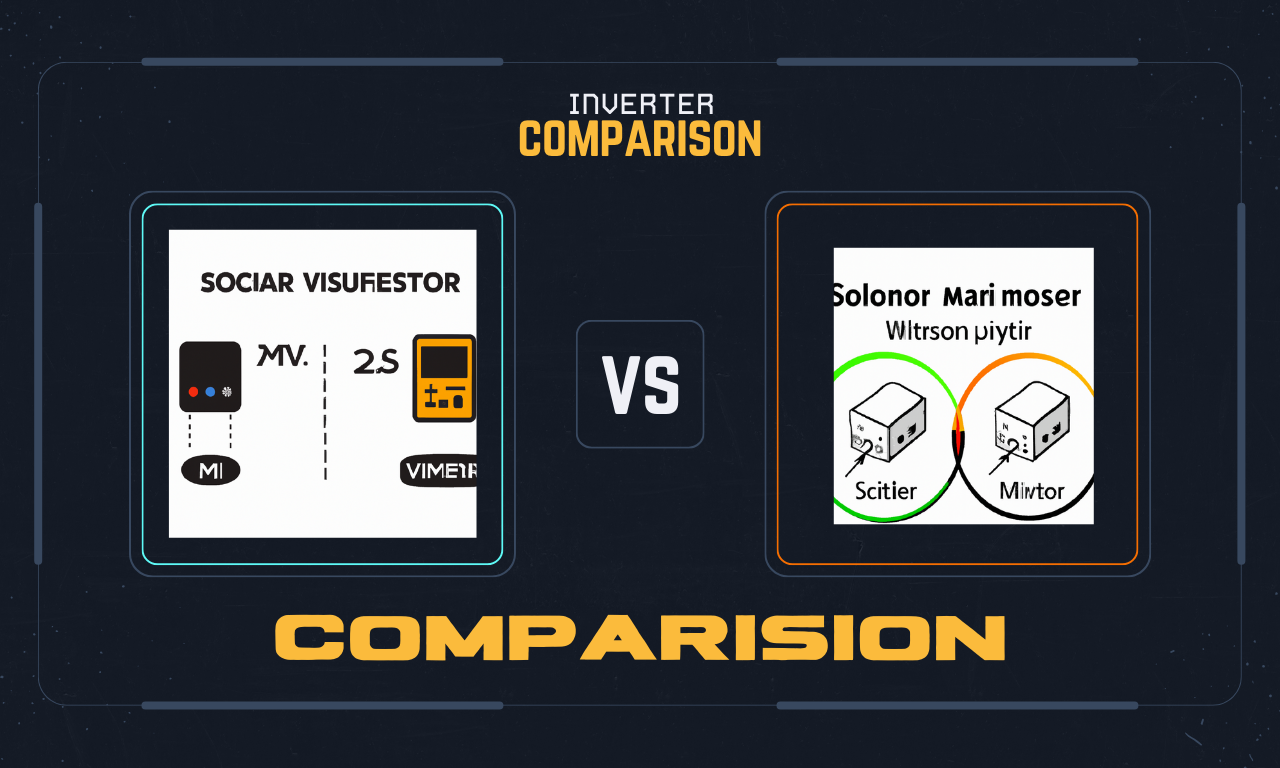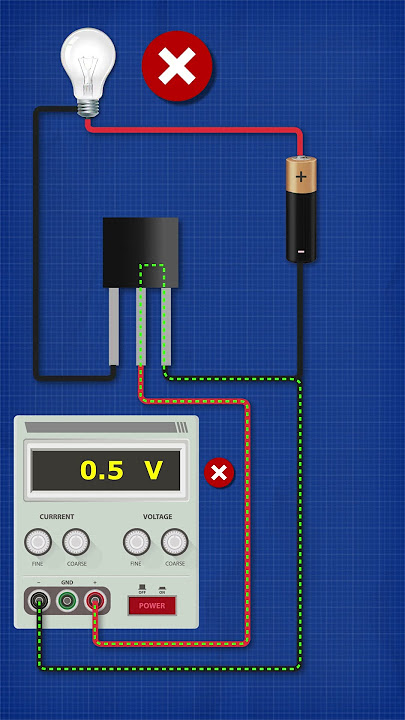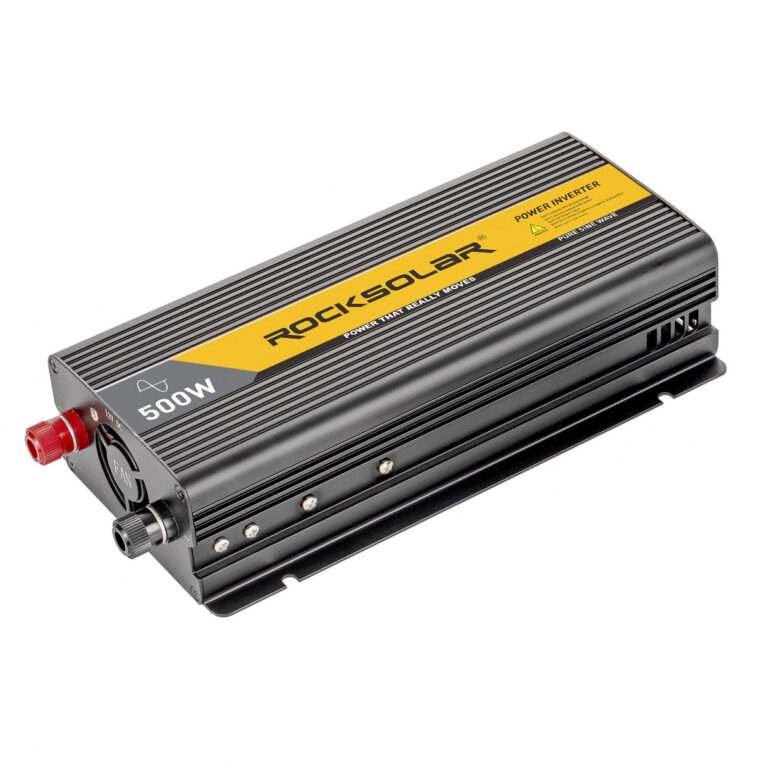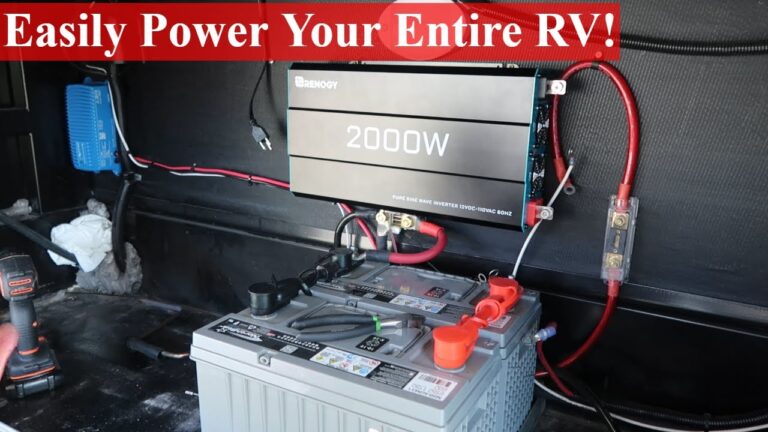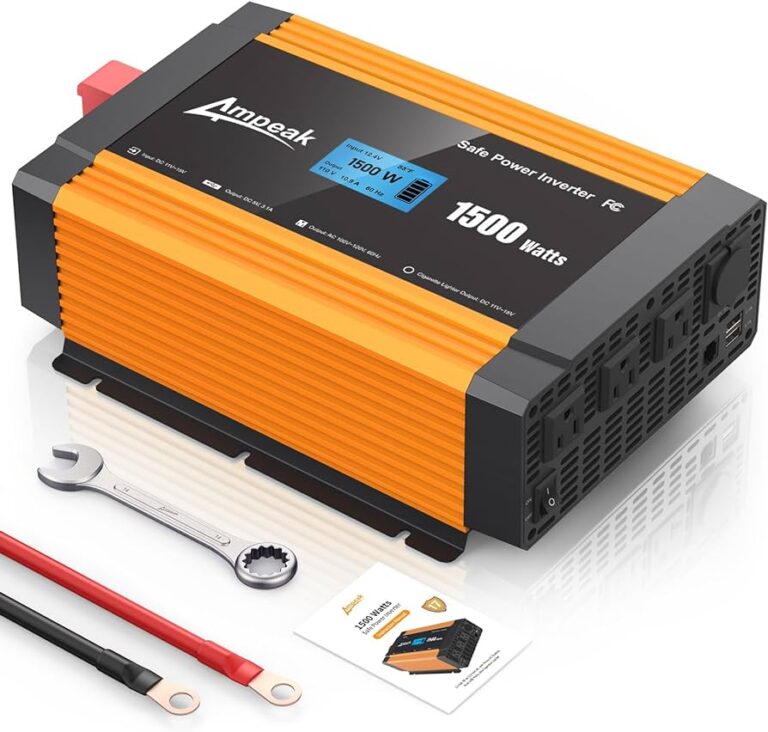Solar Micro Inverter Vs Optimizer: Unleashing the Power of Solar Energy
Solar micro inverters and optimizers are two different technologies used in solar power systems.
Examining The Role Of Solar Micro Inverters
Solar micro inverters and optimizers play distinct roles in the field of solar energy. While micro inverters convert DC power into usable AC power on a per-panel basis, optimizers maximize the efficiency of a solar panel system by providing additional control and monitoring capabilities.
Understanding the differences between these technologies is crucial for optimizing solar energy production.
Solar micro inverters play a crucial role in the efficiency and performance of solar energy systems. Unlike traditional string inverters that convert the DC power generated by solar panels into AC power for the entire array, micro inverters are installed on each individual solar panel, allowing for greater control and optimization.
In this section, we will explore the benefits of solar micro inverters, compare their efficiency and performance to other options, and discuss important considerations when installing them.
Benefits Of Solar Micro Inverters:
- Enhanced energy production: Solar micro inverters optimize the energy production of each individual panel, ensuring that even if one panel is partially shaded or underperforming, the others can still generate maximum power. This feature increases overall system output and maximizes energy harvest.
- Increased system reliability: With a traditional string inverter, the output of the entire solar array can be affected by a single panel’s poor performance. Micro inverters, on the other hand, provide independent power conversion for each panel, reducing the impact of system-wide failures and improving the overall reliability of the system.
- Simplified design and installation: When compared to string inverters, which require complex calculations and careful matching of panel characteristics, micro inverters offer a simpler design process. Each panel operates independently, eliminating the need for string sizing and reducing the risk of mismatching panels.
- Monitoring and maintenance benefits: Solar micro inverters enable panel-level monitoring, allowing homeowners and installers to effectively monitor the performance of each panel in real-time. This detailed monitoring data can help identify issues, such as panel malfunctions or shading problems, quickly and accurately, making maintenance easier and more efficient.
Efficiency And Performance Comparison:
- Higher energy yield: Due to their ability to optimize individual panel performance, solar micro inverters have been shown to increase energy production by up to 25% compared to string inverters. This higher energy yield results in greater savings on electricity bills and a quicker return on investment for solar system owners.
- Improved safety: Micro inverters eliminate high DC voltages, often found in traditional string inverter systems. This feature enhances overall system safety, reducing the risk of electric shocks and electrical fire hazards.
- Better performance in shaded conditions: Shading can significantly impact the output of solar panels. Micro inverters, with their panel-level optimization capability, mitigate the negative effects of shading, ensuring that the system continues to produce power even when some panels are partially obstructed.
Considerations For Installing Solar Micro Inverters:
- Initial cost: Solar micro inverters are typically more expensive than traditional string inverters. While the initial investment may be higher, the increased energy yield and reliability of micro inverters can offset the upfront costs over time.
- Compatibility with panel types: Before installing micro inverters, it is crucial to ensure compatibility with the type and brand of the solar panels being used. Consult with a solar professional to determine the best micro inverter solution for your specific panel type.
- Available space and layout: The physical size of the micro inverters should be considered when planning the installation. Ensure that there is sufficient space on the back of each panel to accommodate the micro inverter and that the panel layout allows for efficient wiring and connectivity.
- Professional installation: Proper installation is essential for optimal performance and safety. Hiring a qualified solar installer experienced in working with micro inverters will ensure a seamless installation process and adherence to local electrical codes and regulations.
Solar micro inverters offer numerous advantages, including enhanced energy production, increased system reliability, simplified design and maintenance, and improved performance in shaded conditions. Although they may involve higher upfront costs and require professional installation, the long-term benefits make them a compelling option for those seeking to optimize their solar energy systems.
Understanding The Advantages Of Solar Optimizers
Solar optimizers offer a range of advantages over solar micro inverters when it comes to enhancing the performance and efficiency of solar panel systems. By providing individual panel optimization, solar optimizers ensure optimal energy production and monitor the performance of each panel, maximizing the overall output of the system.
Additionally, solar optimizers allow for flexible system design and simplify installation and maintenance processes.
Solar optimizers are a key component in the solar power system that help to improve the efficiency and performance of each individual solar panel. Unlike traditional solar micro inverters, which convert the DC power generated by each panel into AC power, solar optimizers work by maximizing the power output at the panel level.
In this section, we will explore the benefits of solar optimizers, compare their efficiency and performance to micro inverters, and discuss important considerations for installing solar optimizers.
Benefits Of Solar Optimizers:
- Improved Energy Harvesting: Solar optimizers enable each panel to perform at its maximum potential, even in the presence of shading, dirt, or mismatched panels. This allows for optimal energy production and higher overall system performance.
- Enhanced Panel-Level Monitoring: With solar optimizers, you can monitor the performance of each individual panel in real-time. This level of granularity provides valuable insights into panel health, detecting any issues such as faults or underperformance.
- Flexibility in System Design: Solar optimizers offer flexibility in system design by accommodating panels with different orientations, tilt angles, or shading conditions. This allows for a customized solar power system that works efficiently in a variety of situations.
- Safer Installation and Maintenance: Solar optimizers provide a safer installation process as they reduce the voltage at the panel level, minimizing the risk of electrical hazards during maintenance or repairs. Additionally, panel-level monitoring makes it easier to identify and address maintenance needs promptly.
- High Scalability: Solar optimizers can be easily added or replaced, making it convenient to scale up or upgrade your solar power system in the future. This scalability allows for greater adaptability to changing energy needs or technological advancements.
Efficiency And Performance Comparison:
Solar optimizers generally offer higher system efficiency compared to solar micro inverters, primarily due to their ability to maximize power output at the panel level. Here are some points to consider when comparing the efficiency and performance of these two technologies:
- Power Output: Solar optimizers increase the overall power output of a solar installation by reducing the power losses caused by shading or panel mismatch. Micro inverters, on the other hand, convert DC to AC power at the panel level, which can result in some power losses.
- System Reliability: Solar optimizers, with their advanced monitoring capabilities, help identify issues at the panel level, ensuring the system operates optimally. Micro inverters, while reliable, may not provide the same level of detailed monitoring and analysis.
- Cost-Effectiveness: Solar optimizers can be more cost-effective in installations where shading or panel mismatch is a concern. Micro inverters tend to have a higher initial cost per panel, especially in scenarios where shading is minimal or panels are well-matched.
Considerations For Installing Solar Optimizers:
When considering the installation of solar optimizers, there are a few key factors to keep in mind. These considerations will help ensure you make an informed decision regarding the implementation of solar optimizers in your solar power system:
- Shading: If your solar panels are subject to shading from nearby trees, buildings, or other obstructions, solar optimizers can greatly improve energy production. Conduct a shading analysis to determine the extent of shading and assess the potential benefits.
- Panel Mismatch: In cases where panels have different orientations, tilt angles, or power ratings, solar optimizers can help mitigate the impact of panel mismatch, optimizing the system’s overall performance.
- Panel-Level Monitoring: If you value detailed insights into the performance of individual solar panels, including the ability to detect any underperforming panels or potential faults, solar optimizers provide a valuable advantage with their monitoring capabilities.
- Electrical Safety: Solar optimizers reduce the risk of electrical hazards during installation and maintenance by reducing the voltage at the panel level. This can make your solar power system safer for both installers and maintenance personnel.
- Scalability: Consider your future plans for system expansion or upgrades. Solar optimizers offer greater scalability, allowing for easier addition or replacement of panels, or the incorporation of new technologies.
Solar optimizers provide undeniable benefits such as improved energy harvesting, enhanced panel-level monitoring, flexibility in system design, safer installation and maintenance, and high scalability. When compared to traditional solar micro inverters, their efficiency and performance advantages make them a compelling choice for optimizing solar power systems.
By considering factors like shading, panel mismatch, and electrical safety, you can make an informed decision about whether solar optimizers are the right solution for your solar installation.
Key Differences Between Solar Micro Inverters And Optimizers
Solar micro inverters and optimizers have key differences. Micro inverters convert DC to AC at the panel level, while optimizers improve efficiency by individually adjusting the output of each panel in a string.
Technology Overview:
Solar micro inverters and optimizers are innovative devices used in solar energy systems to maximize energy generation and optimize system performance. While they serve similar purposes, there are distinct differences in their technologies:
- Solar micro inverters: These devices are installed on each individual solar panel, converting the DC power generated by the panel into AC power for immediate use or export to the grid. Key features include:
- Each panel operates independently, ensuring that the performance of one panel does not affect the others.
- Better energy harvesting in shaded or mismatched panels, as each panel functions at its maximum capacity.
- Reduction in the impact of module-level failures on overall system performance.
- Optimizers: Unlike micro inverters, optimizers are connected to a group of solar panels instead of individual panels. They perform the following functions:
- Optimizers maximize the power output of each panel by tracking the maximum power point (MPP) of the entire group.
- By mitigating module-level mismatch losses, optimizers improve overall system efficiency.
- They allow system monitoring and performance analysis at the module level, providing valuable insights into the system’s performance.
These technologies have different installation requirements and performance implications, making it essential to understand their impact on system performance and maintenance.
Impact On System Performance And Maintenance:
When it comes to system performance and maintenance, solar micro inverters and optimizers have their own advantages and considerations:
- Solar micro inverters:
- Each panel’s independent operation allows for system resilience, as the failure of a single panel does not impact the performance of the entire system.
- Easy identification and replacement of faulty panels, as the monitoring system provides relevant information at the individual panel level.
- Enhanced safety, as micro inverters operate at low voltage levels.
- Higher upfront cost compared to optimizers.
- Optimizers:
- Increased energy harvest due to mitigation of module-level mismatch losses.
- Lower upfront cost compared to micro inverters.
- Simpler installation, as the optimizers are installed on the roof or behind the panels, reducing the requirement for additional electrical work.
- Monitoring at the individual module level allows early detection of underperforming panels.
Considering the different impacts on performance and maintenance, it’s important to choose the technology that aligns with your specific requirements and preferences.
Integration With Existing Solar Setups:
Both solar micro inverters and optimizers can be integrated with existing solar setups; however, the integration process may vary:
- Solar micro inverters:
- Can be easily retrofitted to an existing solar system by replacing the string inverter with micro inverters installed on each panel.
- Provide flexibility in system expansion, allowing the addition of panels without affecting the existing ones.
- Suitable for installations with shading or uneven panel orientations.
- Optimizers:
- Can be integrated by installing them on the existing solar panels, connecting them to a central or string inverter.
- Useful for addressing partial shading and mismatched panel issues in an existing system.
- System expansion may involve additional optimizers to ensure compatibility and optimization.
Whether your aim is to optimize a new installation or improve an existing solar setup, evaluating the integration process of micro inverters and optimizers will help you make an informed decision tailored to your needs.
Solar micro inverters and optimizers offer distinct technologies that impact system performance and maintenance differently. Understanding their features and integration options is crucial in maximizing the benefits of solar energy systems.

Credit: www.greentechmedia.com
Factors To Consider For Solar Micro Inverters
When comparing solar micro inverters and optimizers, there are several factors to consider. These include system efficiency, ease of installation, scalability, cost, and monitoring capabilities. Each option has its pros and cons, so it’s important to evaluate your specific needs and goals before making a decision.
When it comes to choosing between solar micro inverters and optimizers for your solar panel system, there are several factors you should consider. In this section, we will examine some key considerations to help you make an informed decision. Let’s delve into the following factors:
System Size And Layout Requirements:
- Panel-level monitoring: Solar micro inverters provide panel-level monitoring, which allows you to track the performance of individual panels and identify any potential issues. This level of monitoring can help optimize your system’s overall efficiency and provide early detection of any maintenance needs.
- Design flexibility: Solar micro inverters offer greater design flexibility as compared to optimizers. With micro inverters, each panel operates independently, allowing for different orientations and shading conditions. This flexibility can increase your system’s overall output and efficiency, especially in situations where panels receive varying levels of sunlight throughout the day.
- Scalability: If you plan to expand your solar panel system in the future, micro inverters may be the better choice. Due to their independent operation, micro inverters make it easier to add more panels to your existing system without compromising the performance of the entire array.
Compatibility With Other Equipment:
- PV system compatibility: Ensure that the micro inverter you choose is compatible with your specific photovoltaic (PV) panels. Different micro inverters may have different voltage and power rating requirements, so it is crucial to select one that is compatible with your existing or planned solar panel system.
- Battery storage compatibility: If you are considering integrating battery storage into your solar panel system, check the compatibility of the micro inverter with the particular battery technology you intend to use. Some micro inverters may have specific compatibility requirements for seamless integration with certain battery systems.
Cost Considerations And Return On Investment (Roi):
- Installation costs: Solar micro inverters tend to have higher upfront costs compared to optimizers. However, the individual panel-level optimization provided by micro inverters can potentially increase your system’s overall energy production, resulting in better long-term performance.
- Maintenance expenses: Micro inverters generally have lower maintenance requirements compared to string inverters. With fewer components to manage, the maintenance costs associated with micro inverters can be significantly reduced over time.
- Return on investment: Consider the financial benefits that micro inverters can provide. The improved energy production and panel-level monitoring capabilities can lead to higher energy savings and a more favorable return on investment in the long run.
When deciding between solar micro inverters and optimizers, take into account the system size and layout requirements, compatibility with other equipment, and cost considerations. Each of these factors plays a crucial role in determining the optimal choice for your solar panel system.
Factors To Consider For Solar Optimizers
Solar optimizers are essential in maximizing the efficiency of solar panels. When comparing micro inverters to optimizers, factors to consider include cost, design flexibility, and system performance. Optimizers provide a cost-effective solution with improved panel-level monitoring and shade tolerance.
The use of solar optimizers in a solar energy system can greatly enhance its performance and efficiency. When deciding between a solar micro inverter and an optimizer, there are several factors to consider. In this section, we will explore these factors in detail to help you make an informed decision.
System Size And Layout Requirements:
- For larger solar energy systems, with multiple panels or complex layouts, solar optimizers can be an excellent choice. They allow flexibility in system design and accommodate shading issues more effectively.
- Solar optimizers are particularly beneficial when there are variations in panel performance due to factors like cloud cover or debris accumulation.
- In contrast, solar micro inverters are better suited for smaller systems with straightforward layouts, where shading or panel performance variations are minimal.
Compatibility With Other Equipment:
- Solar optimizers can be easily integrated with existing solar inverters, making them a cost-effective option for retrofitting existing systems. They work well with both central inverters and string inverters.
- Opting for a solar micro inverter may require replacing the existing inverter, as they are incompatible with standard string inverters.
- It is crucial to ensure that the chosen optimizer or micro inverter is compatible with the specific solar panels used in the system.
Cost Considerations And Return On Investment (Roi):
- Solar optimizers are generally less expensive than micro inverters, making them a more budget-friendly option for large-scale installations.
- Additionally, the use of optimizers can increase the overall energy production of a solar system, resulting in higher electricity bill savings and a faster return on investment.
- On the other hand, while micro inverters may have a higher upfront cost, they offer individual panel-level monitoring, which can help identify and address any performance issues more effectively, potentially increasing the system’s long-term performance and ROI.
Considering these factors will enable you to choose the most suitable option for your solar energy system, in terms of system size and layout requirements, compatibility with other equipment, and cost considerations. It is crucial to evaluate your specific needs and consult with a solar professional to make an informed decision.
Best Practices For Installation And Maintenance
Solar micro inverters and optimizers are both popular options for solar panel installation and maintenance. While micro inverters convert DC power to AC power for each individual panel, optimizers optimize each panel’s output before sending it to a central inverter.
Both options have their advantages and it is important to consider factors such as panel layout and shading when choosing between the two.
Proper Installation Techniques
Proper installation techniques play a crucial role in ensuring the optimal performance and longevity of solar micro inverters and optimizers. Here are some best practices to follow:
- Positioning: Place the inverters and optimizers in shaded areas to prevent overheating. Install them securely on a sturdy surface, away from moisture and extreme weather conditions.
- Wiring: Ensure proper wiring connections, using appropriate connectors and cables. Follow the manufacturer’s instructions and recommended wire sizes for the specific system.
- Grounding: Implement a reliable grounding system to minimize electrical shock risks and maintain system safety.
- Mounting: Use appropriate mounting hardware and follow the manufacturer’s guidelines when affixing the inverters and optimizers.
Regular Maintenance And Monitoring
Regular maintenance and monitoring are essential to keep your solar system running smoothly. To ensure optimal performance, consider the following:
- Check for physical damage: Regularly inspect the inverters and optimizers for any signs of physical damage. Address any issues promptly to avoid further problems.
- Cleanliness: Keep the devices free from dirt, debris, and dust accumulation. Regularly clean the panels and inspect for shading or obstructions that can impact system efficiency.
- Firmware updates: Stay updated with the latest firmware releases from the manufacturer. Regularly check for updates and install them as recommended.
- Performance monitoring: Utilize monitoring systems to track the performance of your solar system. Regularly review the data to identify any anomalies or issues that may require attention.
Troubleshooting Common Issues
Even with proper installation and maintenance, occasional issues may arise. Here are some common problems and troubleshooting tips:
- Faulty connections: Check all wiring connections for loose or damaged components. Ensure that all connections are secure and tight.
- Low output or power loss: Inspect the panels for shading, dirt, or damage. Clean the panels and remove any obstructions. If the issue persists, contact a solar professional for further assistance.
- Inverter or optimizer errors: Check the manufacturer’s documentation for error code explanations and troubleshooting suggestions. If necessary, reach out to the manufacturer’s support team for guidance.
- Communication issues: If the inverters or optimizers are not communicating with the monitoring system, verify the network connectivity and settings. Ensure that the devices are properly configured for communication.
Remember, following proper installation techniques, performing regular maintenance, and addressing any issues promptly will help maximize the efficiency and longevity of your solar micro inverter and optimizer system.
Optimizing Solar System Performance
Optimizing solar system performance is crucial, and choosing between a solar micro inverter and optimizer can make a big difference. These technologies effectively manage and enhance energy production, ensuring maximum efficiency for your solar power system.
Solar energy is a renewable and clean source of power that has gained popularity in recent years. When it comes to implementing a solar system, it is crucial to optimize its performance to maximize energy production and balance system efficiency with costs.
This article explores the benefits of using solar micro inverters and optimizers for achieving optimal performance and discusses additional optimization options to enhance the overall effectiveness of your solar system.
Maximizing Energy Production:
- Micro inverters: These devices are installed on each solar panel, converting the panel’s DC power into AC power. By operating independently, micro inverters enable each panel to perform to its maximum potential, even in case of shading, dust, or other efficiency-reducing factors. This ensures that you generate the highest amount of energy possible.
- Optimizers: Similar to micro inverters, optimizers are designed to enhance the performance of solar panels. Unlike micro inverters, however, they function by optimizing the DC power output from each panel and then converting it to AC power using a central inverter. Optimizers enable you to monitor and manage the performance of individual panels, providing better visibility into the overall system.
Balancing System Efficiency And Costs:
- Micro inverters: While micro inverters contribute to higher energy production, they come at a higher initial cost compared to traditional string inverters. However, their ability to optimize individual panel performance often outweighs this cost, making them a worthwhile investment for maximizing system efficiency.
- Optimizers: Optimizers, on the other hand, offer a hybrid option by combining the benefits of micro inverters and traditional string inverters. They provide the advantages of module-level optimization while utilizing a single central inverter, reducing overall costs. This makes optimizers a cost-effective choice for those seeking enhanced performance without incurring the full expense of micro inverters.
Exploring Additional Optimization Options:
- Solar tracking systems: These systems automatically adjust the positioning of solar panels throughout the day to optimize their exposure to sunlight. By tracking the sun’s movement and adjusting the panel orientation, solar tracking systems can significantly improve energy production, especially in regions with varying sun angles.
- Battery storage solutions: Adding battery storage to your solar system allows you to store excess energy generated during peak production periods and utilize it during times of low production or high demand. This ensures that you can optimize energy use and reduce reliance on the grid, resulting in greater overall efficiency.
- Smart energy management systems: Integrating a smart energy management system with your solar system enables real-time monitoring, data analysis, and remote control. These systems provide insights into energy consumption patterns and allow you to automate energy usage based on optimal conditions, further enhancing the performance and efficiency of your solar system.
Implementing a solar system involves more than just installing panels and an inverter. To truly optimize the performance of your solar system, considering the benefits of solar micro inverters, optimizers, and other additional optimization options is crucial. By maximizing energy production, balancing system efficiency and costs, and exploring additional optimization options, you can ensure that your solar system operates at its full potential, reducing your carbon footprint and saving on energy costs.
Planning For Future Expansion And Upgrades
Solar micro inverters and optimizers are both great options for planning future expansion and upgrades in your solar system. While micro inverters offer individual panel performance monitoring and increased energy production, optimizers allow for panel-level optimization and flexibility. Choose the option that suits your needs and goals for a more efficient and reliable solar installation.
Solar Micro Inverter Vs Optimizer:
As renewable energy continues to gain popularity, more and more homeowners are considering the benefits of solar energy. Two key components of a solar photovoltaic (PV) system are the micro inverter and the optimizer. While both serve the purpose of maximizing energy production, they have distinct features that make them suitable for different scenarios.
In this blog post, we will focus on the scalability considerations, retrofitting existing systems, and adapting to changing energy needs when it comes to planning for future expansion and upgrades.
Scalability Considerations:
- Scalability is an important factor to consider when planning for future expansion of your solar PV system. Both micro inverters and optimizers offer scalability options, but they differ in terms of ease of expansion.
- Micro inverters provide a more straightforward approach to scalability as each panel is equipped with its own micro inverter. This means that adding more panels to your system is as simple as installing additional micro inverters. It allows for easy expansion and better customization of your system according to your energy needs.
- On the other hand, optimizers require a central inverter that can handle the total power output of all the panels in the system. To expand your system with optimizers, you may need to upgrade your central inverter, which can be more complex and costly.
Retrofitting Existing Systems:
- If you already have a solar PV system in place and are considering upgrades, both micro inverters and optimizers offer retrofitting options.
- Micro inverters can be a convenient choice for retrofitting as they can be easily added to each panel in the existing system without requiring major changes. This allows you to maximize the energy production of your current installation without the need for a complete overhaul.
- Optimizers also offer retrofitting options by integrating with existing systems. However, for optimal performance, it is recommended to assess the compatibility of the existing components and make necessary adjustments or upgrades. This ensures that the newly added optimizers work seamlessly with the existing infrastructure.
Adapting To Changing Energy Needs:
- One of the challenges of investing in a solar PV system is predicting the future changes in your energy needs. Both micro inverters and optimizers have features that can help adapt to these changing needs over time.
- Micro inverters provide individual panel-level monitoring, allowing you to pinpoint any issues or inefficiencies in your system. This level of visibility enables you to optimize the performance of each panel and make adjustments as your energy needs change. It provides flexibility and fine-tuning options to ensure optimal energy production.
- Optimizers also offer monitoring capabilities, but at the string level rather than the panel level. This means that you can monitor the performance of a group of panels, rather than each individual panel. While this may not provide the same level of granularity as micro inverters, it still allows you to identify and address any potential issues in real-time.
When planning for future expansion and upgrades of your solar PV system, it is essential to consider scalability, retrofitting options for existing systems, and the ability to adapt to changing energy needs. Both solar micro inverters and optimizers offer unique advantages in these areas.
By carefully assessing your specific requirements and consulting with a professional, you can determine the best solution that aligns with your long-term goals and ensures optimal energy production.
Frequently Asked Questions For Solar Micro Inverter Vs Optimizer
Are Micro-Inverters Better Than Optimizers?
Micro-inverters and optimizers have their own advantages depending on the specific solar system requirements.
What Is The Difference Between String Inverter Micro Inverter And Optimizers?
String inverters, micro inverters, and optimizers all convert solar energy into usable electricity. However, they differ in how they manage the output. String inverters handle multiple panels in a series, micro inverters work on a panel-by-panel basis, and optimizers enhance the performance of individual panels.
What Is The Difference Between Tigo Optimizer And Microinverter?
Tigo Optimizer and Microinverter have different functions. Tigo Optimizer optimizes energy production from each solar panel. Microinverter converts DC to AC power at each panel.
Are Solar Optimizers Worth It?
Yes, solar optimizers are worth it as they improve solar panel performance and help increase energy production.
Conclusion
As we wrap up our discussion on solar micro inverters vs optimizers, it’s clear that both technologies offer distinct advantages in terms of energy production and system performance. Whether you opt for a micro inverter or an optimizer depends on your specific needs and preferences.
Micro inverters, with their individual MPPT tracking, provide higher efficiency and improve the overall output of each solar panel. On the other hand, optimizers maximize the energy yield of a system by mitigating the impact of shading or module mismatch.
Ultimately, it’s important to consider factors such as cost, installation requirements, and system size when making your decision. By harnessing the power of solar micro inverters or optimizers, you can take full advantage of solar energy and reduce your carbon footprint.
Make sure to consult with a solar professional to determine which technology is the most suitable for your unique situation.

